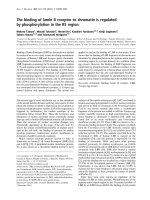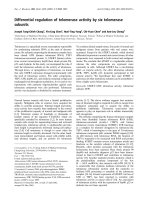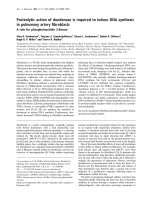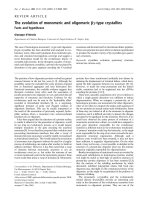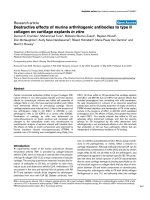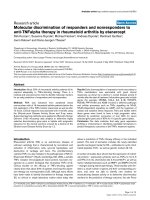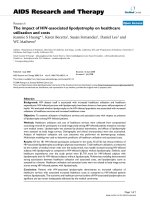Báo cáo y học: " Possible transmission of HIV Infection due to human bite" potx
Bạn đang xem bản rút gọn của tài liệu. Xem và tải ngay bản đầy đủ của tài liệu tại đây (246.58 KB, 3 trang )
CAS E REP O R T Open Access
Possible transmission of HIV Infection due to
human bite
Alaka K Deshpande
1*
, Shivaji K Jadhav
2
and Atmaram H Bandivdekar
2
Abstract
The potential risk of HIV-1 infection following human bite although epidemiologically insignificant, but it is
biologically possible. There are anecdotal reports of HIV trans mission by human bites particularly if saliva is mixed
with blood. The oral tissues support HIV replication and may serve as a previously unrecognized HIV reservoir. The
HIV infected individuals have more viruses in blood than saliva, possibly due to the potent HIV- inhibitory properties
of saliva. The case presented here is of a primary HIV infections following a human bite where in the saliva was
not blood stained but it got smeared on a raw nail bed of a recipient. The blood and saliva of the source and
blood of the recipient showed a detectable viral load with 91% sequence homology of C2-V3 region of HIV gp120
between the two individuals. The recipient did not receive PEP [post exposure prophylaxis] as his family physician
was un aware of salivary transmission. The family physician should have taken PEP decision after proper evaluation
of the severe and bleeding bite. Hence it is necessary to treat the HIV infected human bites with post exposure
prophylaxis.
Introduction
The epidemiological data has supported the premise that
HIV tra nsmission via saliva is low or non-exi stent due to
inhibitory factors in saliva. The risk of HIV-1 infection
following human bite although epidemiologically insignif-
icant, but it is biologically possible [1,2]. Animal studies
with rhesus macaques shows the infants are more suscep-
tible to oral infections [3]. The oral trauma, co-infections
with other sexually transmitted pathogens, periodontal
dis ease s, concomi tant ulcerative lesions, further enhance
oral HIV tr ansmission . The human bites as a rare risk
factor for HIV transmission [4]. Some patients are hyper-
excretors [5] they have high levels of infectious HIV in
their saliva than in blood. These hyper-excretors may be
at risk of transmitting the virus to their partners e ven
though the blood viral load is low.
An interesting case of HIV transmission following a
human bite is reported.
Case report
On 29 March 2010, a 44 year’s old man (Mr.A) a known
case of NIDDM (Non-insulin dependent diabetes
mellitus) and hypertension for past four years under
treatment was brought to the hos pital with history o f
high grade fever and increasing drowsiness for past four
days.
Clinical examination r evealed a drowsy febrile patient
without focal neurological deficit or meningeal signs. A
clinical diagnosis of malaria, metabolic encephalopathy
with sepsis was made, later the patient had two episodes
of generalized tonic-clonic convulsions and was treated
with midazolam and Loarazepam followed by phosphe-
nytoin along with IV Artes unate. Basic investigations
were normal. Malarial parasites were not detected. Com-
puterized tomography (CT) Brain showed nonspeci fic
changes. CSF was suggestive of viral meningitis. Despite
inj. Acyclovir drowsiness continued. He was negative for
HBV, HCV, and HSV. The HIV Duo test was weakly
positive. (Mr. A) did not provide any history of unpro-
tected sex or multiple sex partners, nor any intravenous
drug use i n past or present, His spouse is HIV negative,
The HIV-I viral load on the 4
th
day of hospitalization
was >750,000 c opies/ml (Cobas Taqman 48 Real time
PCR) and The CD4
+
cell count was 396 c ells/mm
3
.A
diagnosis of acute HIV infection was considered and
TDF+FTC+EFV were started as per DHHS guidelines.
As the sensorium improved, details from patient
revealed that his foster son (Mr.X) who was HIV-1
* Correspondence:
1
Department of Medicine and Head of ART Centre, Grant medical college
and Sir J J Gr.of Govt Hospitals, Byculla, Mumbai - 400008 India
Full list of author information is available at the end of the article
Deshpande et al. AIDS Research and Therapy 2011, 8:16
/>© 2011 Deshpande et al; licensee BioMed Central Ltd. This is an Open Access article distributed under the t erms of the Creati ve
Commons Attribution License ( which pe rmits unrestricted use, distribution, and
reproduction in any m edium, provided the original work is properly cited.
positive, due to heterosexual acquisition. He was drug
naïve with CD4 cell count 460 cells/mm
3.
On 1
st
March
father and son duo, had an a rgument during which the
son severely bit the left thumb of the father (Figure 1).
During the incident the thumb nail of (Mr.A) came out
leaving behind a raw bleeding nail bed.
Clinical examination of (Mr.X) revealed that his oral
hygiene was good, absence of oral ulcers, caries no
bleeding in gums. There were no physical injury, cuts or
scratches occurred during t he argument. The patient
consulted his family physician who did not advice PEP,
as salivary transmission of HIV is rare and negligible.
On 29 March 2010, four weeks after the inci dence.(Mr
A) was hospitalized and his HIV Duo test was weakly
positive and his viral load was high (2,470,000 copies/ml).
The case thus indicates acquisition of HIV infection
through saliva not contaminated with blood, following a
human bite. The blood samples of both the father-son
duo and saliva of the sourc e (Mr.X) were coll ected on 12
April 2010, these samples were analyzed for confirmation
of HIV DNA by amplifying C2-V3 Region of HIV1C
envelope gene and further confirmed by PCR and
sequencing. Peripheral blood mononuclear cells
(PBMCs) were isolated by Ficoll-hypaque method. DNA
from these PBMCs was extracted using Qiagen DNA
mini kit and used for PCR [Qiagen, GmbH, Hilden,
Germany]. The C2-V3 regi on of env gene was amplified
(Figure 2) by nested PCR by heteroduplex mobility assay
(HMA) using primers [6] obtained from NIH AIDS
Research and Reference Reagent Programme (NIH,
Bethesda, USA) to determine HIV variants and subtypes.
The C2-V3 region of second round product was
sequenced. Sequence revealed 91% homology between
Mr.A and Mr. X (Table 1). The C2-V3 region of HIV1C
env gene shows the presence of five N-linke d glycosyla-
tion (NLG) s ites in (Mr A) While in case of (Mr.X)
showed six potential NLG sites. The presence of single
NLGsiteatV3regionofHIV1Cenv gene s howed in
both the individuals suggesting the possible usages of
CCR5 tropic virus.
The virological and immunological parameters of Mr
X and Mr A were measured (Table 2). The HIV-1 viral
load in the blood and saliva was estimated using the
MagNa pure Compact Nucleic Acid Automated System
(Roche Diagnostic GmbH, Germany) with Cobas
Figure 1 shows the condit ion of the nail four weeks after the
bite.
1kb Ladder Mr.A Mr. X
Figure 2 PCR amplification of C2-V3 region of HIV1C env gene
from PBMCs.
Table 1 Translated Amino acid sequences of C2-V3
Region of HIV 1C env gene from Peripheral blood
mononuclear cells (PBMCs)
ID 225 231 241 251 260
AILKCKD NTF NGT GPCN NVSTVQCTHG IKPVVSTQLL
XIIKCND ETS N KT GPCN NVSTVQCTHG IRPVVSTQLL
261 271 281 295
ALNGSLAEEVV II-SKNLTDN TETIIVQLDE AVEIT
XLNGSLAEKEI IIRSENLTDN AKTIIVHLNE S VEII
296 301 311 321 330
A CTRPT NNTRKSIRIG PGQTFYATGD IIGNIRRAYC
X CTRPN NNTRKSIRIG PGQTFYATGD IIGNIRQAYC
♦italic letters Indicate - NLG sites and bold letter indicates variation
♦Starts C2 region of HIV1gp 120 followed by V3 region Starts at 296 and end
at 330 positions
Table 2 Virological and Immunological parameters
Sample ID Sample CD4 count Cells/μl Viral Load Copies/ml
Mr.A
(Pt.)
Blood plasma 396 2,470,000
Mr.X
(Source)
Blood Plasma 383 17163
Saliva NA 2405
Salivary Cells NA 165
NA- not applicable
Deshpande et al. AIDS Research and Therapy 2011, 8:16
/>Page 2 of 3
TaqMan 48 Real time PCR (Roche Molecular Systems
Branchburg, NJ, USA).
Evidence from the reports of Healthcare workers
(HCWs) bitten by HIV infected toddlers highlights uni-
versal precautions should be taken [7]. The potential
transmission of HIV 1 by human bite retroviruses has
also been reported [8 ] Detection of HIV-1 in saliva has
implications for case identification, clinical monitoring
and surveillance for drug resistance [9] which also
reveals detectable salivary HIV RNA may be a useful
analyte for detec tion of HIV infection for monitoring
responses to ARV therapy.
Conclusions
Our observations revealed transmission of HIV infection
from the smear of non-contaminated saliva of [Mr.X]
on the raw and bleeding nail bed of (Mr.A) To con-
clude, the family physician should have taken PEP deci-
sion after proper evaluation of t he severe and bleeding
bite. Hence it is necessary to treat the HIV infected
human bites with post exposure prophylaxis.
Consent
Written informed consent was obtained from the patient
for publication of this case report and accompanying
images. A copy of the written consent is available for
review by the Editor-in-Chief of this journal.
Acknowledgements
All staffs of Department of Biochemistry and Virology National Institute for
Research in Reproductive Health (NIRRH) ICMR and ART Centre Sir J J Group
of Govt Hospitals Mumbai, India. We are grateful to Indian Council of
Medical Research, Government of India for the Senior Research Fellowship
to Shivaji K Jadhav.
Author details
1
Department of Medicine and Head of ART Centre, Grant medical college
and Sir J J Gr.of Govt Hospitals, Byculla, Mumbai - 400008 India.
2
Biochemistry Division, National Institute for Research in Reproductive Health
(NIRRH), Indian Council of Medical Research (ICMR), J M Street, Parel,
Mumbai - 400 012, India.
Authors’ contributions
AKD - Case identifications, clinical Aspects of the study, drafted the
manuscript. SKJ - Experimental design, molecular biology experiments, DNA/
RNA isolations, Viral load, PCR, Interpretation of data, Sequence analysis, AHB
- Experimental design, data analysis, Interpretation of data, drafted
manuscript
All the authors read and approved the final manuscript
Competing interests
The authors declare that they have no competing interests.
Received: 23 December 2010 Accepted: 31 March 2011
Published: 31 March 2011
References
1. Tereskerz TM, Bentley M, Jagger J: Risk of HIV-1 infection after human
bites. Lancet 1996, 348: 1512.
2. Richman KM, Richman LS: The potential for transmission of human
immunodeficiency virus through human bites. J Acquir Immune Defic
Syndr 1993, 64: 40-46.
3. Chenine AL, Regina FF, Lehmann H, Vangel MG, McClure HM, Ruprecht RM:
Older Rhesus Macaque Infants Are More Susceptible to Oral Infection
with Simian-Human Immunodeficiency Virus 89.6P than Neonates Virol.
2005, 2: 1333-1336.
4. Bartholomew CF, Jones AM: Human bites: a rare risk factor for HIV
transmission. AIDS 2006, 4: 631-632.
5. Shugars DC, Patton LL, Freel SA, Gray LR, Vollmer RT, Eron JJ Jr, Fiscus SA:
Hyper-excretion of human immunodeficiency virus type 1RNA in saliva.
J Dent Res 2001, 2: 414-420.
6. Delwart EL, Sheppard HW, Walker BD, Goudsmit J, Mullins JI: HIV-1
evolution in vivo tracked by DNA heteroduplex mobility assays. J Virology
1994, 68: 6672-6683.
7. Shirly LR, Ross SA: Risk of transmission of human immunodeficiency virus
by bite of an infected toddler. J Pediatrics 1989, 3: 424-427.
8. Andreo SM, Barra LA, Costa LJ, Sucupira MC, Souza E, Diaz RC: HIV type 1
transmission by human bite retroviruses. AIDS Res Hum Retroviruses 2004,
20: 349-350.
9. Balamane M, Winters MA, Dalai SC, Freeman AH, Traves MW, Israelski DM,
Katzenstein DA, Klausner JD: Detection of HIV-1 in saliva: Implications for
case-Identification, clinical monitoring and surveillance for drug
resistance. The open Virology Journal 2010, 4: 78-83.
doi:10.1186/1742-6405-8-16
Cite this article as: Deshpande et al.: Possible transmission of HIV
Infection due to human bite. AIDS Research and Therapy 2011 8:16.
Submit your next manuscript to BioMed Central
and take full advantage of:
• Convenient online submission
• Thorough peer review
• No space constraints or color figure charges
• Immediate publication on acceptance
• Inclusion in PubMed, CAS, Scopus and Google Scholar
• Research which is freely available for redistribution
Submit your manuscript at
www.biomedcentral.com/submit
Deshpande et al. AIDS Research and Therapy 2011, 8:16
/>Page 3 of 3
